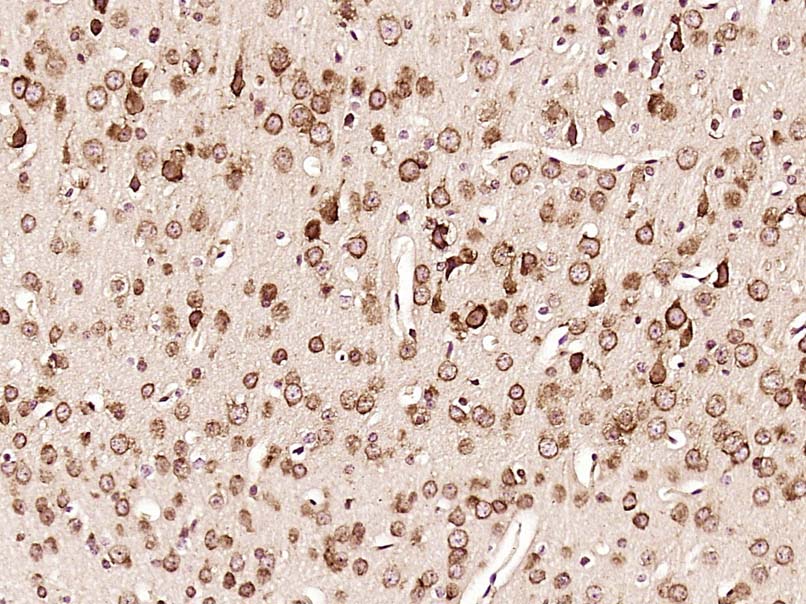
Rabbit Anti-FABP3/H-FABP antibody
MDGI; FABP11; H-FABP; M-FABP; O-FABP; Fatty acid-binding protein, heart; Fatty Fatty acid-binding protein 3; Heart-type fatty acid-binding protein (H-FABP); Mammary-derived growth inhibitor (MDGI); Muscle fatty acid-binding protein (M-FABP); FABPH_HUMAN;
View History [Clear]
Details
Product Name FABP3/H-FABP Chinese Name 心型脂肪酸Binding protein/脂肪酸Binding protein3抗体 Alias MDGI; FABP11; H-FABP; M-FABP; O-FABP; Fatty acid-binding protein, heart; Fatty Fatty acid-binding protein 3; Heart-type fatty acid-binding protein (H-FABP); Mammary-derived growth inhibitor (MDGI); Muscle fatty acid-binding protein (M-FABP); FABPH_HUMAN; Cardiac FABP. literatures Research Area Cardiovascular Signal transduction Stem cells Immunogen Species Rabbit Clonality Polyclonal React Species Mouse, (predicted: Human, Rat, Dog, Pig, Cow, Horse, Rabbit, Sheep, ) Applications ELISA=1:5000-10000 IHC-P=1:100-500 IHC-F=1:100-500 ICC=1:100-500 IF=1:100-500 (Paraffin sections need antigen repair)
not yet tested in other applications.
optimal dilutions/concentrations should be determined by the end user.Theoretical molecular weight 15kDa Cellular localization cytoplasmic Form Liquid Concentration 1mg/ml immunogen KLH conjugated synthetic peptide derived from human FABP3: 8-100/133 Lsotype IgG Purification affinity purified by Protein A Buffer Solution 0.01M TBS(pH7.4) with 1% BSA, 0.03% Proclin300 and 50% Glycerol. Storage Shipped at 4℃. Store at -20 °C for one year. Avoid repeated freeze/thaw cycles. Attention This product as supplied is intended for research use only, not for use in human, therapeutic or diagnostic applications. PubMed PubMed Product Detail Fatty acid-binding proteins, designated FABPs, are a family of homologous cytoplasmic proteins that are expressed in a highly tissue-specific manner and play an integral role in the balance between lipid and carbohydrate metabolism. FABPs mediate fatty acid (FA) and/or hydrophobic ligand uptake, transport and targeting within their respective tissues. The mechanisms underlying these actions can give rise to both passive diffusional uptake and protein-mediated transmembrane transport of FAs. FABPs are expressed in adipocytes (A-FABP), brain (B-FABP), epidermis (E-FABP, also designated psoriasis-associated FABP or PA-FABP), muscle and heart (H-FABP, also designated mammary-derived growth inhibitor or MDGI), intestine (I-FABP), liver (L-FABP), myelin (M-FABP) and testis (T-FABP). MDGI is highly expressed in the myocardium, skeletal and smooth muscle fibers, lipid and/or steroid synthesizing cells and terminally differentiated epithelia of the respiratory, intestinal and urogenital tracts.
Function:
FABP are thought to play a role in the intracellular transport of long-chain fatty acids and their acyl-CoA esters.
Subcellular Location:
Cytoplasm.
Similarity:
Belongs to the calycin superfamily. Fatty-acid binding protein (FABP) family.
SWISS:
P05413
Gene ID:
2170
Database links:Entrez Gene: 2170 Human
Entrez Gene: 14077 Mouse
SwissProt: P05413 Human
SwissProt: P11404 Mouse
Product Picture
Bought notes(bought amounts latest0)
No one bought this product
User Comment(Total0User Comment Num)
- No comment



 +86 571 56623320
+86 571 56623320
 +86 18668110335
+86 18668110335

